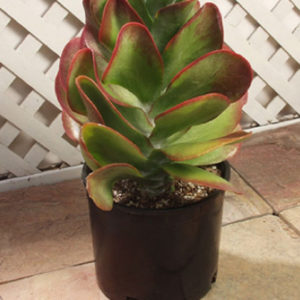Light: This plant grows best in bright light. It will even enjoy some direct sun. Sunlight brings out the red colour on the leaves edges.
Soil: The plant is easy to grow in average room conditions, tolerating the dry air of heated homes well. It however doesn’t like is soggy soil, so plant in fast draining soil.
Care: Do not wet the leaves as this will lead to rot.
Category: Plants Options
Related products
-
 Quick view
Quick viewCalathea
Light: Light shade or dappled light indoors. Do not expose to direct, noon sun as it will fade the leaf colors. Water: High humidity. Keep soil continuously moist throughout spring and summer, and reduce watering in the winter. Temperature: Prefers warm and humid conditions. Keep above 60ºF if possible. Soil: A well-drained potting mix. Fertilizer: Feed regularly with liquid fertilizer throughout growing season.Read more -
 Quick view
Quick viewDracaena ‘Lemon Lime’
Temperature: Keep in a warm room preferably where the dracaena can get consistent direct sunlight. Water: Water only when the top inch of the soil is dry to avoid over watering as it may lead to root rot. Fertilizer: Use soluble/liquid fertilizer especially when growing( sprouting new foliage)Read more -
 Quick view
Quick viewBromeliad
Light: Bright, filtered or indirect sunlight is best. Direct sunlight may burn leaves especially broader leaves. Soil: Keep the soil evenly moist, but do not over-water or allow the plant roots to stand in water. Water: Should be planted in well – draining soil to avoid water-logging. Temperature: Ideal temperature range of 55-85ºF (13-29ºC) works best for bromeliads.Read more -
 Quick view
Quick viewSansevieria Laurentil
Light: Although they are very forgiving, the sansevieria prefers bright light with some sun. They can adapt to full sun. Water: Let the soil dry between waterings. During winter, reduce watering to monthly, or whenever the soil is dry to the touch. Err on the side of underwatering. Temperature: They prefer warmth and will suffer if exposed to temperatures below 50ºF. Soil: A loose, well-drained potting mix. They will do well in sandier soils. Fertilizer: Feed a mild cactus fertilizer during the growing season; do not fertilizer in the winter.Read more



Reviews
There are no reviews yet.